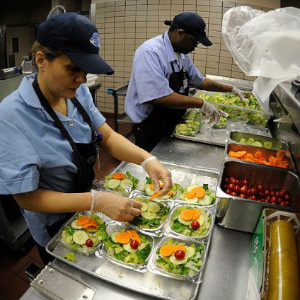It’s been reported, many times over the past few months, that the restaurant and greater foodservice industry is having trouble getting qualified workers, and that’s holding back the post-COVID recovery in their sector. Now, one Canadian provincial government is stepping in to bolster training…
 (L-R) Sir Humphrey Appleby, Prime Minister Jim hacker and Assistant Bernard
(L-R) Sir Humphrey Appleby, Prime Minister Jim hacker and Assistant Bernard
Wolley. “Governments don’t support programs because they do any good.
They support programs that show what they approve of.”
Since the COVID-19 pandemic descended upon the world, and foodservice operations all but closed down for the duration, many former resto workers and even some operators have left the business, looking for other careers. We’re told that many aren’t applying for the recently re-opened opportunities in the foodservice job market because they have been inspired to seek better jobs with better pay.
So where does that leave the industry?
Worker shortages in the hospitality sector as a whole are nothing new, though. Back in 2010, I read that there were tens of thousands of resto and foodservice jobs across Canada going unfilled even then. But now, the situation has become even more serious. So, the government of Ontario has decided to step in and jump-start the stalled machine, investing almost $1 million to prepare over 600 people across the province for rewarding careers in food and beverage processing. This funding to Food and Beverage Ontario provides job seekers with training, mentorship, and job placements with local employers in baking, food science, and food production and processing.
“Ontario’s food and beverage workers have kept shelves stocked and our province running throughout the pandemic,” said Monte McNaughton, Minister of Labour, Training and Skills Development. “I’m proud to support this exciting project, which is giving people a head start in pursuing rewarding careers while ensuring employers have access to the trained, highly-skilled workers they need to grow our economy and strengthen communities across the province.”
Merely a token effort, you sneer?
You may say that the fostering of 600 fledgling careers in food and bev doesn’t make any material difference in an industry where almost 100,000 positions remain unfilled. But I suspect the government – as governments do – is making an example it expects others, in the private sector, to follow. It’s also using the announcement of the program to underscore the new reality of resto and foodservice jobs.
The official news release emphasizes, “Workers in food processing, transportation and warehousing, where job postings have nearly doubled over the past year and a fifth of the workforce is preparing to retire, can earn upwards of $25 an hour.” When you remember that the minimum wage has been raised substantially over the past decade, and foodservice operators have been raisin their wage offerings in an effort to attract the workers who are available, that $25-an-hour rate doesn’t seem unreasonable. What it indisputably does illustrate is a renaissance in how folks view resto jobs: It’s well over twice what most resto workers were making before COVID.
What this means to consumers
Flipping the coin for a moment, this definitely means higher menu prices for resto and catered food. On the other hand, the take-out trend-that-just-won’t-die is being eagerly adopted as the new resto business model by operators both in fast food and fine dining. Most of the major fast food operators have already announced ‘resto of the future’ concepts which minimize dine-in seating and optimize for take-out and drive-thru operations. The vendors stand to save big on the cost of staff they’ll no longer need as well as maintenance and other overhead costs.
They may just be able to keep costs down – or at least slow their rise to a rate at which nobody notices. When the Big Mac first appeared on the McMenu in 1985, it sold for $2.59. Today it sells for $5.69. And that’s in line with inflation over those years. I guess the rule, for restos, is to keep the rate of menu price increases at or below the rate of inflation.
Meanwhile, folks – especially young folks – are getting more and more addicted to the idea of food delivery services, in spite of the added cost they represent. Here, I invoke the millennial love of convenience over low prices as an explanation. Generations that came before food delivery services, and experienced delivery overwhelmingly by pizza and Chinese restaurants, had two things to say about delivery: “I expect to tip the driver,” but, “I don’t expect to pay a surcharge.” The younger generations have grown up without that ‘understanding’ and seem to accept the cost of delivery as a ‘just part of the deal’, and not really a component of the overall cost of the food. One younger person I read about is reported to have said, “It would cost more than $3 to drive to a restaurant and pick up my order. What’s the difference?” In reality, it would only cost about $1 to go and pick up a McOrder. But try telling a convenience addict that. I guess they don’t mind funding a whole, new, largely unnecessary industry!
But I digress…
Sir Humphrey Appleby, the Cabinet Secretary to Prime Minister Jim Hacker on Yes, Prime Minister, once explained to his protégée, Bernard Wooley, that: “Governments don’t support programs because they do any good. They support programs that show what they approve of.”
Muse on that…
~ Maggie J.

